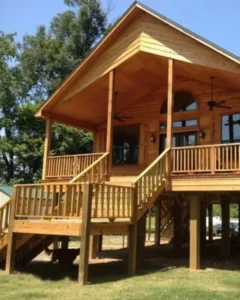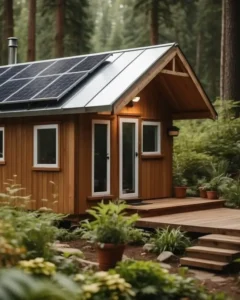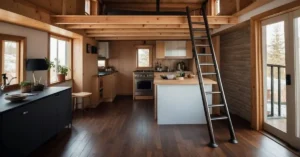For those in a hurry, here’s an overview of the pros and cons of a house on stilts!
| Pros | Cons |
|---|---|
| ✅ Protection against flooding | ❌ Potential structural defects |
| ✅ Increased ventilation and airflow | ❌ Higher construction costs |
| ✅ Maximized views | ❌ Limited accessibility for people with disabilities |
| ✅ Improved security from vermin and pests | ❌ Vulnerability to high winds and storm damage |
| ✅ Utilization of shaded space under the house | |
| ✅ Better privacy from street level |
If you want the more detailed version, read on. At the end of the article I have summarised some inspirations with pictures for you.
Benefits of Tiny Homes on Stilts
Space Utilization

One of the biggest advantages of Tiny Homes on stilts is the efficient use of space. When you build a tiny home on the ground, you are limited by the size and shape of the lot. However, when you build on stilts, you can take advantage of the vertical space, creating more room without increasing the footprint of the house. Small houses on stilts, for example, offer the possibility of using the area under the house as a garage. With careful planning and design, a small house on stilts can feel very spacious and comfortable.
Flood Protection
Another advantage of tiny homes on stilts is the protection they offer against flooding. By elevating the home off the ground, you can reduce the risk of water damage during floods and heavy rains. This can be especially important if you live in an area prone to flooding or near a body of water.
Additionally, building a tiny home on stilts can help you comply with local building codes and regulations related to flood zones. By elevating the home above the floodplain, you can avoid costly flood insurance premiums and protect your investment in the home.
Improved View

Finally, living in a tiny home on stilts can offer stunning views of the surrounding landscape. By elevating the home, you can take advantage of panoramic views of mountains, oceans, or forests. This can create a sense of connection to nature and improve your overall quality of life.
Designing Tiny Homes on Stilts

Materials and Structure
One of the most important decisions you’ll need to make when designing a tiny home on stilts is what materials to use. Steel framing and corrugated metal siding are popular choices for their lightweight and wind-resistant properties. However, wood can also be a great option if you’re looking for a more traditional look and feel.
In addition to the materials, you’ll also need to consider the structural elements of your tiny home on stilts. The foundation, for example, will need to be strong enough to support the weight of the home while also withstanding the elements. You may also want to consider adding additional supports or braces to ensure the stability of the home.
Interiors and Space Management
When designing a tiny home on stilts, space management is key. You’ll need to make the most of every inch of space, while also ensuring that the home feels comfortable and livable. One popular approach is to use multi-functional furniture, such as a sofa that can be converted into a bed or a table that can be folded away when not in use.
Another important consideration is storage. You’ll need to find creative ways to store your belongings without taking up too much space. Built-in shelving, hanging organizers, and under-bed storage are all popular options.
For inspiration on matching furniture and creative store solutions feel free to check out our “2 Bedroom Tiny House Interior” article!
Inspirations for Tiny Homes on Stilts
Tiny Farmhouse on Stilts

Tiny Beachhouse on Stilts

Tiny House made of Stone

Tiny Treehouse on Stilts

Wooden Tiny Home on Stilts

Tiny House with Gallery on Stilts

Potential Challenges and Solutions
As with any type of housing, tiny homes on stilts are not without their potential challenges. However, with careful planning and design, many of these challenges can be overcome.
Stability Concerns
One of the primary concerns when building a tiny home on stilts is ensuring that it is stable and secure. This is especially important in areas that are prone to earthquakes, high winds, or flooding. To address these concerns, it is important to work with an experienced architect or engineer who can design a sturdy foundation and structure that can withstand these types of natural disasters.
Another potential stability concern is the weight of the home. Since tiny homes on stilts are typically smaller and lighter than traditional homes, they may be more susceptible to tipping or shifting in high winds or other extreme weather conditions. To address this, it is important to ensure that the home is properly anchored and that the foundation is designed to support the weight of the structure.
Accessibility Issues
Another potential challenge with tiny homes on stilts is accessibility. Since these homes are elevated off the ground, they may not be suitable for individuals with mobility issues or disabilities. To address this, it is important to consider adding features such as ramps or lifts to make the home more accessible.
Additionally, it is important to ensure that the home is designed with safety in mind. This may include features such as handrails or guardrails to prevent falls, as well as proper lighting to ensure that the area around the home is well-lit and easy to navigate.
What is the best material for stilt houses?
The best material for stilt houses depends on factors such as the location, climate, and budget. Common materials include wood, bamboo, cement, and stone. Each material has unique advantages and disadvantages, and the choice should be based on the specific needs of the project.
Are stilts uncomfortable?
Stilts can be uncomfortable to wear for extended periods of time, especially if they are not properly fitted or if the user is not accustomed to wearing them. However, comfort straps and other accessories can help alleviate discomfort and improve stability.
How tall are most tiny homes?
The height of most tiny houses is around 14 feet, which is the maximum legal height for a roadworthy trailer. Some tiny houses may have higher ceilings or lofts, which can add several feet to the overall height.
If you liked this blog article about the topic “Tiny Homes on Stilts”, don’t forget to leave us a comment down below to tell us about your experience.
Feel free to also check out our other Articles from the category “Tiny House“ and don’t forget to follow us on Pinterest.



